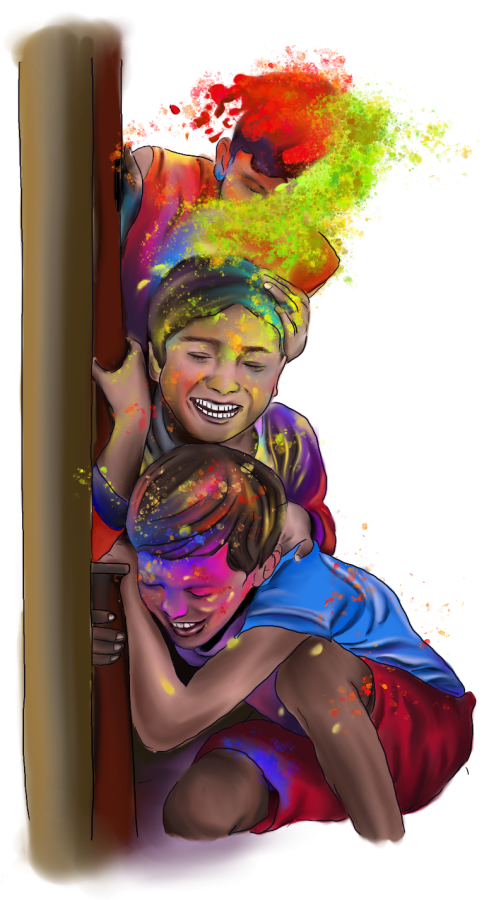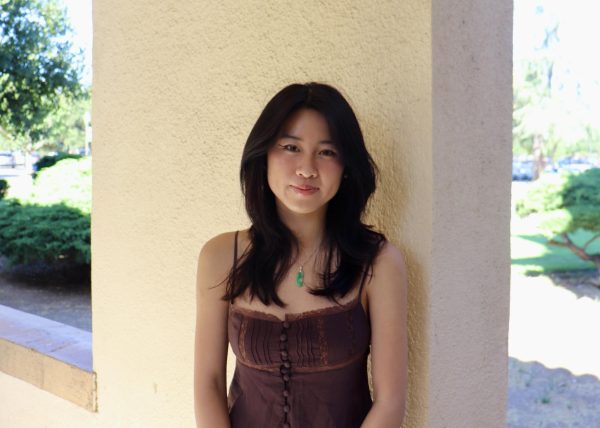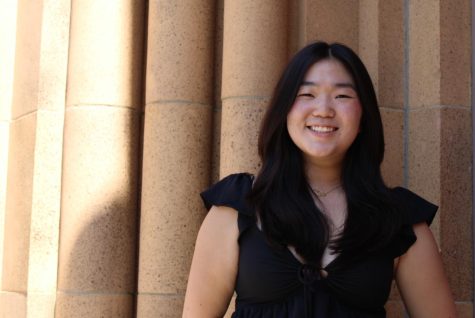Blooming Festivities
Spring celebrations around the world
Passover and Purim: Building Community
In many cultures, spring time signifies new life and beginnings. Through Purim and Passover, Jewish people celebrate spring in their own special ways.
The first Jewish holiday of the spring season is Purim, a holiday where people dress up and tell stories from the Book of Esther. This holiday has given senior Arielle Blumenfeld a strong female figure to look up to.
In order to celebrate, many families engage in dressing up and other fun activities.
“This is your opportunity to dress up, play with noisemakers and have a lot of fun baking cookies called Hamantaschen,” Blumenfeld said.
Purim has created many fond childhood memories for Blumenfeld.
“I remember dressing up and going through all my Disney princess dresses and deciding which one of them I wanted to be,” Blumenfeld said.
While Purim has many fun aspects to it, being able to spend time with loved ones has a lot of significance for some.
Passover is another Jewish holiday that is celebrated during the Springtime, in order to commemorate the Israelites’ Departure from Egypt. This holiday focuses on a big dinner and reading excerpts from the Torah, the holy book of Judaism.
Freshman Ella Segev has always celebrated Passover with her family by following certain traditions.
“Traditionally you’re supposed to read the entire story out of the Torah but that will literally take hours,” Segev said. “So we recite a condensed version of the story and during the meal you eat traditional foods like matzah which is like flattened bread and you just have a feast.”
Blumenfeld’s family opts for the more traditional route when it comes to celebrating passover.
“We go through a lot of rituals around our table and we do the whole two-hour ceremony where you read, we take turns around the table reading and at a certain point you’d be able to eat certain things on the Seder plate,” Blumenfeld said.
In addition to the big feast, some families have fun Passover traditions of their own, which create lasting memorie.
“For Passover, my dad and my family make us put towels over our heads, and we have to reenact coming to the pharaoh, as Jews before we were held captive,” Segev said. “We had to come to the pharaoh as Jews, and we’d be like, we’re super hungry, please take us in and once we reenacted it and embarrassed ourselves, we would get two eggs instead of one.”
Through this holiday, families are able to both celebrate religiously and place value on the social aspect that comes with holidays.
“I think something that’s really beautiful about Passover is just that the people that are at your table are really close family and friends, so it’s always just a really intimate feeling that you might not necessarily get on like on a regular Friday night,” Blumenfeld said. “Friday is Shabbat, so it’s really nice to have a big family dinner with your extended family.”
These holidays are extremely meaningful and significant for many Jewish people, but people who do not celebrate these holidays often know little to nothing about them.
“I do wish we would [bring more awareness to these holidays] because I feel like a lot of people have different opinions about Jewish people,” Segev said. “I feel like if they just got more exposed to the Jewish heritage and how we celebrate things, it would be a lot better.”
Even though these holidays are not well-known to everyone, those who do celebrate them take great pride in their traditions within their communities.
“I feel like for the communities that celebrate them, I’ve definitely been in situations where I’ve seen them celebrated very beautifully,” Blumenfeld said. “Communities like my synagogue and my youth group have almost made me feel like it’s a very normal and regular holiday, until I mention it in some other contexts and other people don’t really know too much about them.”
Purim and Passover hold significance to Jewish people and are special ways that they honor traditions and their religion.
“Overall, I don’t think that they’re under-celebrated at all,” Blumenfeld said. “I think that the celebrations and growing communities are beautiful.”
Hinamatsuri: the Doll Festival
Beautiful and intricate ornamental dolls are arranged on several large, red carpet-covered tiers while brightly-colored, smaller dolls made of silk hang from red strings to create a colorful exhibit of traditional Japanese decorations. This special display is a part of Hinamatsuri, the Japanese holiday celebrated annually on March 3, which is also known as “Girl’s Day,” “Doll’s Day,” and previously as the “Peach Festival.”
The dolls, also known as hina-ningyo, represent a traditional court during the Heian period (794 – 1185). Historically, the Heian court would perform a ceremony where they would transfer impure thoughts into paper dolls and then send the dolls down a river to symbolize purification and ward off evil spirits.
Teruko Kamikihara, Palo Alto High School’s Japanese teacher, explains the significance behind Hinamatsuri.
“When a girl is born, the first Hinamatsuri is very important. Usually before the first Hinamatsuri, the grandparents will buy and display the doll set,” Kamikihara said.
The hina dolls can be expensive—around a few thousand dollars for a complete set—but they are usually passed down in a family through generations.

Naoko Fujii, a Palo Alto resident, describes her experiences celebrating Hinamatsuri when she was younger.
“My favorite holiday as a child was Hinamatsuri,” Fujii said. “My mother [would] set up the dolls that she was given from her mother in precise order.”
The dolls are usually sorted into five to seven tiers for display purposes, and the order is always the same.
The first platform is for the emperor and empress; the second is for three court ladies who serve saké (an alcoholic beverage made from fermenting rice) to the emperor and empress; the third is for five male musicians; the fourth is for ministers or bodyguards, with two covered bowl tables and two stands with hishimochi (sweet diamond-shaped mochi made of a pink jasmine-flavored layer, a white chestnut-flavored layer, and a green mugwort-flavored layer) between them; the fifth is for three helpers of the emperor and empress, with a mandarin orange tree on the rightmost side and a cherry blossom tree on the leftmost side.
In addition to the intricate decorations, there are many types of foods traditionally eaten on Hinamatsuri that are meant to bring good luck.
“We eat sakura mochi [light pink mochi with sweet red bean filling wrapped in a sakura leaf] on Hinamatsuri,” Kamikihara said. “The pink color means cheerfulness, and we eat them every year.”
Oseki han (special red bean rice) is also made in celebration. Other foods may include hishimochi, chirashizushi (a traditional style of a mix of Japanese sushi ingredients in a bowl), hina arare (sweet flavored rice crackers) and shirozake (sake mixed with mochi-gome).
Although widely celebrated in Japan, Hinamatsuri is not a commonly known holiday amongst non-Japanese people.
“I never thought of expanding [Hinamatsuri’s] reach,” Fujii said. “I saw it as an obscure Japanese girl thing we celebrate among ourselves.”
Kamikihara is open to sharing the customs of Hinamatsuri with others.
“When I used to teach at Gunn, a social studies teacher asked me if it was ok to bring his class to see the Hina dolls that I displayed in class,” Kamikihara said. “Of course I said yes. I also show my Hina dolls to my colleagues in the PALY world language department every year [when] I display them.”
Traditionally, boys do not participate in Hinamatsuri; however, they have their own day on May 5, known as “Boy’s Day”—although it has been recently changed to “Children’s Day.”
“[My family and I] had a party every year where only the girls in the family were invited,” Fujii said. “We dressed up in Japanese kimonos and enjoyed the only celebration of the year where only women were invited.”
Holi: a Festival of Colors and Unity
The rich bass of dhols (double sided drum) fills the air as masses of people unite to participate in the most colorful holiday of the year. The smell of fresh sweets like gulab jamuns and cooling drinks like lassi are ever so tempting as the color wars begin. Vibrant reds, blues, pinks, yellows and greens paint the faces of those who run, trying to escape the onslaught, or those who race to attack their friends and family. The scene is a classic, one of numerous celebrations that surround the holiday of Holi.
Holi, the vivacious and vivid festival that is predominantly celebrated in south India, represents the exuberance of life. It’s a day of forgiveness, amity, oneness and equality. It is also a tribute to the triumph of good over evil. Holi is split into two events: Holika Dahan and Dhulivandan, also known as Rangwali Holi.
Holika Dahan, which takes place the night before Dhulivandan, is marked by the burning of wood and dung cakes to symbolize good defeating evil. The sacred bonfire is worshiped. In the Hindu legend, one of the most famous mythological stories of the legend of Holi involves an evil king named Hiranyakashyap who stopped his son Prahlad from worshiping the God Vishnu. Hiranyakashyap had a sister named Holika, who he told to burn Pralhad, but the God Vishnu helped Prahlad and burned his wicked aunt Holika to death to signify the victory of good over evil. Holika begged Prahlad for forgiveness before her demise. Therefore, Prahlad announced that she would be remembered every year at Holi. This is why the burning of Holika is celebrated as Holi across India. Dhulivandan occurs the morning after Holika Dahan. It is celebrated by people throwing handfuls of colored powder at one another playfully while getting drenched in water. In addition to worshiping the God Vishnu, Holi commemorates the Gods Radha and Krishna.
Working in the finance department of a high tech company and living in Pune, India for his entire life, Chetan Guive recalls his childhood experiences celebrating the tradition.
“In my childhood, a week or few days prior to Holi, we would prepare things like filling balloons with colored water and water guns so that we can play on Holi day,” Guive said. “My sister used to prepare ornaments made up of cow dung to burn it in the bonfire on Holika Dahan nigher and in our village, it was a nice celebration for which people come together and exchange sweets.”

Paly junior Isha Nadkarni recalls a similar childhood experience, as she lived in India for seven years.
“My most memorable Holi has to be when I was around seven,” Nadkarni said. “My friends and neighbors in my apartment building, as well as some of my school friends, met in the parking lot area of the building and we all had an amazing time spraying each other with water, smearing color, and chucking water balloons at each other. The celebration lasted for hours on end, and I still remember it like it was only last year.”
Having lived in India and now living in the U.S, Nadkarni has observed significant differences in how the Holi tradition is represented and celebrated.
“Holi is extremely popular with people of Indian background since most people partake in the celebration regardless of their religious beliefs,” Nadkarni said. “However, in America, I often see similar color-throwing celebrations being labeled as a ‘color walk’ with no credit or mention of the original tradition nor its roots. Even though I don’t view this as necessarily ‘cultural appropriation,’ it is still a bit disappointing to see one of my favorite cultural traditions being overshadowed and unrecognized.”
Despite the misrepresentation of the Holi tradition in America, Nadkarni still remains optimistic and believes that alleviating this issue and informing more people about this tradition will reveal the beauty of the holiday to those that aren’t aware.“I would love for people in America to partake in Holi, and hopefully learn about its background as well,” Nadkarni said. “It is crucial to preserve this tradition in America, and make sure that it doesn’t lose its true meaning of equality and oneness.”
Ultimately, the true heart of Holi does not rely on elaborate celebrations or festivities. It is the emotions that the festival invokes in people that makes it so special.
“I love [Holi] because the sight of everyone coming together just gives me so much joy and happiness and the colors show the brightness of our culture and our people,” Guive said.

2022-2023 Staff Writer
2023-2024 Creative Director
Journalism is integral in every society across the globe as it is how people stay informed. It...

2021-2022 - Staff Writer
2022-2023 - Business Manager
I joined C mag because art has always been a big part of my life. I always loved looking through...







